PROVINCETOWN — The Beech Forest off Race Point Road is a unique part of the Outer Cape: a rare, gentle, and unlikely ecosystem that stands in contrast to the hardscrabble environment of sand dunes and pitch pines that surrounds it. It is a relic of the past, a glimpse into natural history. The story of the Beech Forest is one of serendipity and perseverance — characteristics that, if it is to survive, may matter now more than ever.
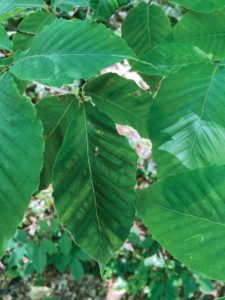
A tiny creature has begun to show up there: Litylenchus crenatae mccannii, a nematode that feeds on beech leaves, which appears to pave the way for pathogens to attack the trees. Beech leaf disease is so new that it is not possible to find definitive numbers on its mortality rate.
It was first discovered in northeastern Ohio in 2012 and is considered a serious threat to that state’s native beech stands. The disease has spread rapidly but sporadically through the Northeast. Its presence has been confirmed in West Virginia, Virginia, Pennsylvania, New Jersey, New York, Connecticut, Rhode Island, Massachusetts, and Maine.
Beech leaf disease was detected in Provincetown’s Beech Forest last year by state monitors, the National Park Service, and arborists looking for signs of its arrival.
“The disease first presents as dark green banding on the leaves,” said Ken MacPhee, an ISA-certified arborist with Bartlett Tree Experts (ISA is the International Society of Arboriculturists).
“After feeding for the first season, the nematode moves into the forming buds at the branch tips. As the buds open the following season, the nematode has already caused damage to the new soft leaf tissue.” As the disease progresses, the foliage becomes deformed, curls, and eventually turns brown. Over the course of 5 to 10 years of repeated seasonal assaults, the trees weaken and succumb to secondary infections.
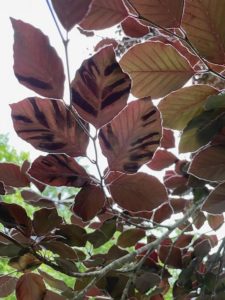
Those studying the progress of the beech leaf disease nematode believe it is spread by birds, said MacPhee. This would explain the rapid spread of the disease over long distances and its ability to reach isolated stands such as the one in Provincetown.
The disease is starting to show up in other locations around the Cape as well. It has been seen in Orleans, MacPhee said. “I haven’t seen it in Wellfleet or Truro, but it has to be there,” he added. In Provincetown, the Beech Forest is a favored environment for birds, a migratory hot spot for hundreds of species, making it a magnet for the pathogen.
This forest ecosystem is a rarity on Cape Cod, said Mark Adams, a retired National Park Service ecologist. “You need special conditions to support a beech forest — water, deeper soils, and shelter from storm winds,” he said. This is an uncommon mix on the exposed, sandy tip of the Outer Cape.
What we now call Provincetown was formed by ocean currents drawing sand from the beaches to the south and depositing it in long spits that extended northward into the ocean. “These sand spits lay out in parallel,” said Adams, “and over time, the troughs between them collected sediments that turned into soil.” These are the pockets of unusually rich soil that support local beeches.
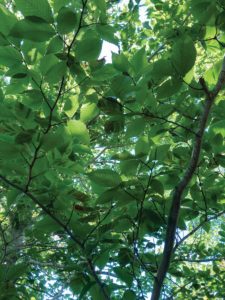
The Beech Forest here has contended with other threats. Today’s stands escaped the clear-cutting done by European colonists, which created the Outer Cape’s desert landscape of poverty grass and wind-blown sand described by Thoreau.
‘The Worst Thing I’ve Seen’
Asked if the beech trees of Provincetown might be saved from the fate of the beeches of Ohio, Heather Faubert, director of the Plant Protection Clinic at the University of Rhode Island, said she is worried. “I’ve been working at U.R.I. for 41 years,” she said, “and this is the worst thing I’ve seen.”
Foresters describe a sense of urgency as well as helplessness about the appearance of beech leaf disease in Provincetown, where the care and preservation of the forest is the responsibility of the National Park Service, Adams pointed out. “If the Park Service doesn’t protect it, what will?” he asked.
One question, then, is when the Park could intervene. Lack of long-term data about treatments and the disease itself present a hurdle. When it comes to beech leaf disease, said Park plant ecologist Stephen Smith, “we’ve just started educating ourselves about it.” The Park’s approach would be to “wait for the science,” he said.
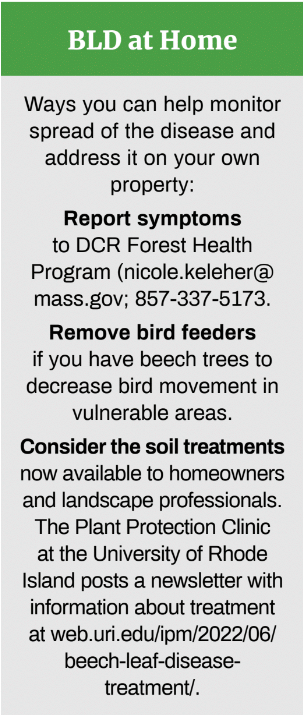
On the other hand, because the pathogen spreads rapidly and treatments require time, the Park would need to act quickly, said Douglas Still, a Rhode Island-based ISA-certified arborist who has been following the spread of the disease, including on the Outer Cape, where he is a frequent visitor. “Treatment would have to happen next summer” to be most effective, Still said.
MacPhee said it could be feasible to treat selected areas — stands that are logistically accessible and where it is environmentally safe to carry out treatment. The goal, in his view, would be to save at least some of the native population in hopes it might eventually reforest the area.
Treatments for the disease are being tested at various sites. According to U.R.I.’s Faubert, “Ohio researchers have had some encouraging results treating trees with potassium phosphite products,” resulting in a decrease in nematode numbers after five years. The treatment is applied as a soil drench or injection directly to the root zone and bolsters the trees’ health, she said.
MacPhee, who said his employer is working in collaboration with other experts to find solutions, believes there is reason for optimism: “There’s a soil treatment that has been working well, and a foliage treatment that has been phenomenal. With these two treatments together,” he believes “there is a possibility of saving some trees.”
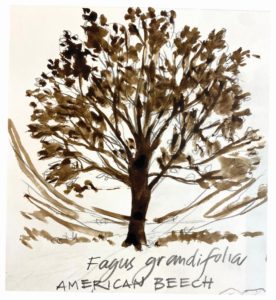
According to MacPhee, Bartlett has offered the National Park Service soil drench treatment at cost and foliar treatments at no cost.
“We have been in touch with our national invasive species team regarding treatment,” said Cape Cod National Seashore Supt. Brian Carlstrom.
Treatment at Scale
Scale is another issue when it comes to meaningful treatment in the Park. Treatments so far, according to Faubert, make sense only at the scale of a back yard. The Beech Forest covers approximately 40 acres of a diverse landscape. “I can’t see treating a whole forest,” Faubert said of the soil treatments.
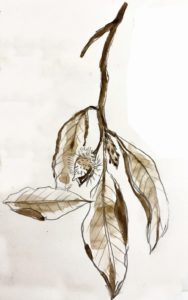
Then there’s the fact that the Beech Forest is on a highly sensitive wetland that sits close to groundwater, and the soil treatment is essentially a concentration of nutrients. “We’re always trying to prevent nutrients from entering our wetlands,” said ecologist Smith. “I don’t know that we can use this treatment here.” After a pause, Smith continued, “I have a feeling we’re at the mercy of this thing.”
A particularly discouraging challenge with this disease is its mode of transport and infection, according to Smith. The Beech Forest is an environment attractive to birds. If birds prove to be the primary carrier of the nematode, as is believed, continued reinfection is inevitable. “Even if we eradicate it from this area, birds could spread it right back,” said Smith.
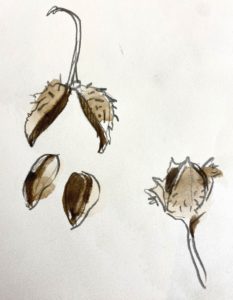
A healthy ecosystem is one promising sign for the Beech Forest, given the information we have today. A good indicator of a healthy forest is regeneration: the appearance and health of new young trees. “Walking through the Beech Forest,” said Adams, “I see plenty of regeneration.”
Faubert also pointed to some promising observations on the resilience of beeches. Trees that have suffered complete defoliation of their first flush of leaves have been seen to produce a secondary flush. “When the secondary buds emerge, and the trees refoliate in June,” she said, “the new flush is often unaffected.”
A healthy tree has the capacity to regenerate and rebound from most stressors — “as long as it has a following period of recovery,” said Adams.
“It would be nice to report something certain about the fate of this forest,” he added, “but sometimes all you can do is pose questions and raise awareness.”



